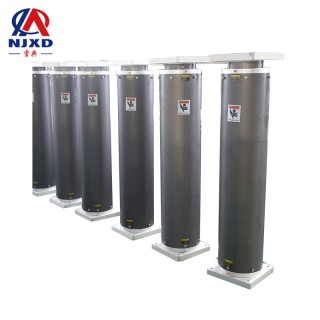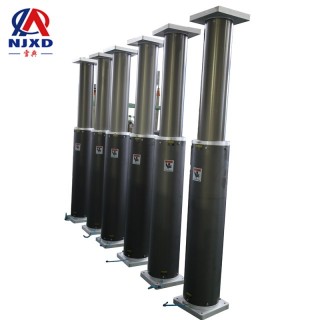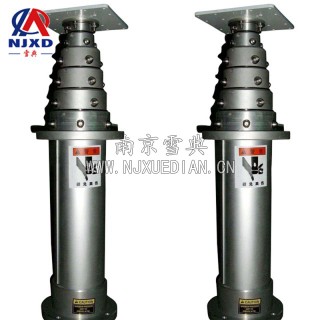NEWS
Cylinder raw materials and sealing data of universal pneumatic lift rod
Time:2020-07-10 View:

1. Cylinder raw material -- aluminum alloy 6063-T5
Type: 6063 aluminum alloy
The primary alloy elements are magnesium and silicon, which have excellent processing function, excellent weldability, extrudability and electroplating property, excellent corrosion resistance and resistance, and are easy to polish and color coating, anodic oxidation has excellent effect and is a typical extrusion alloy. 6063 aluminum alloy profiles are widely used in building profiles, irrigation pipes for many advantages such as their outstanding plasticity, moderate heat treatment strength, outstanding welding function and the rich color and luster of the surface after anodic oxidation treatment, etc, pipes, rods and profiles for vehicles, racks, furniture, lifts, gates, etc.
The density of 6063 is 2.69g/cm3
6063 chemical composition: iron (Fe)0.35
Manganese (Mn)0.1
Magnesium (Mg)0.45~0.9
Silicon (Si)0.2~0.3
Zinc (Zn)0.1
Titanium (Ti)0.1
Chromium (Cr)0.1
Copper (Cu)0.1
Aluminum (Al) residual heat treatment code -- (title)
T1 -- artificial aging
T2 -- annealing
T4 -- solid solution treatment plus natural aging
T5 -- solid solution treatment with incomplete artificial aging
T6 -- solid solution treatment plus complete artificial aging
T7 -- solid solution treatment and stabilization treatment
Solution treatment: it refers to the heat treatment skill of heating the alloy to the high-temperature single-phase zone and insisting on constant temperature, making the excess phase fully dissolved into the solid solution and then cooling quickly (water cooling) to obtain the supersaturated solid solution.
Incomplete artificial aging: select relatively low aging temperature or shorter heat preservation time to obtain excellent comprehensive mechanical function, that is, to obtain relatively high strength, outstanding plasticity and endurance, but the corrosion resistance function may be relatively low.
Complete artificial aging: select higher aging temperature and longer heat preservation time to obtain the maximum hardness and the highest tensile strength, but the elongation is low.
Stabilization treatment: in order to make the shape and scale of the workpiece change under the condition of long-time running, the heat treatment within the regular scale can be adhered.

2. Sealing data-nitrile rubber
Title: nitrile rubber; acrylonitrile-butadiene rubber
Properties: a class of synthetic rubber prepared by emulsion polymerization of butadiene and acrylonitrile. The appearance is light yellow solid with relative density of 0.91~0.986. Acrylonitrile is a non-crystalline rubber with random dispersion in the molecular chain.
Nitrile rubber is a kind of rubber with excellent oil-resistant and heat-resistant functions. Due to the presence of polar nitrites in its structure, it is very important for non-polar or weak polar mineral oil, animal and vegetable oil, fuel oil and solvent both have high stability. Nitrile rubber has a wide application temperature scale and can be used for a long time in the air at 120℃. The oil-resistant function and heat-resistant function of nitrile rubber improve with the increase of the content of acrylonitrile, but the cold resistance, wear resistance and elasticity of the rubber decrease with the increase of the content of acrylonitrile. There are more than 320 types and grades of nitrile rubber, which can be divided according to the content of binding acrylonitrile: 42% ~ 46% is extremely high nitonitrile, 36% ~ 41% is high nitonitrile, 31% ~ 35% is medium high nitonitrile, 25% ~ 30% are medium nitrites and below 25% are low nitrites. According to the polymerization temperature, there are: high temperature polymerization of nitrile rubber, using potassium persulfate as the initiator, polymerization temperature of 30 ~ 500℃, also known as hard nitonitrile rubber; Low temperature polymerization of nitonitrile rubber, using isopropylbenzene hydroperoxide-sodium ethylenediamine tetraacetate-ferrous sulfate-carved white powder as the initiator, the polymerization temperature is 5 ~ 100℃, which is also called soft nitrile rubber. The quality and processing function of soft nitrile rubber are better than that of hard nitrile rubber. There is also a method of classification according to the thickness of Munni value, physical condition and anti-aging agent, etc. Nitrile rubber is primarily used for producing oil-resistant rubber products, and is widely used for finished molding products, finished pressing products, finished sponge products, finished asbestos products, industrial rubber rollers, oil-resistant rubber shoes, wires and cables, mountant, plasticizer and building materials.

CATEGORY
NEWS
- Triangular bracket self-locking type manual lifting bracket pull type bolt self-locking
- Cylinder raw materials and sealing data of universal pneumatic lift rod
- Surface treatment of universal pneumatic lift rod
- Company and technical indicators of pneumatic lift rod
- Performance advantages and customization of pneumatic lifting bracket